Aboriginal storytelling is essential for cultural preservation and community identity. This article explores traditional methods across regions, highlights the importance of contemporary relevance, and discusses practices like digital preservation and intergenerational knowledge transfer. By examining these angles, we can appreciate how Aboriginal narratives adapt while maintaining their rich heritage.
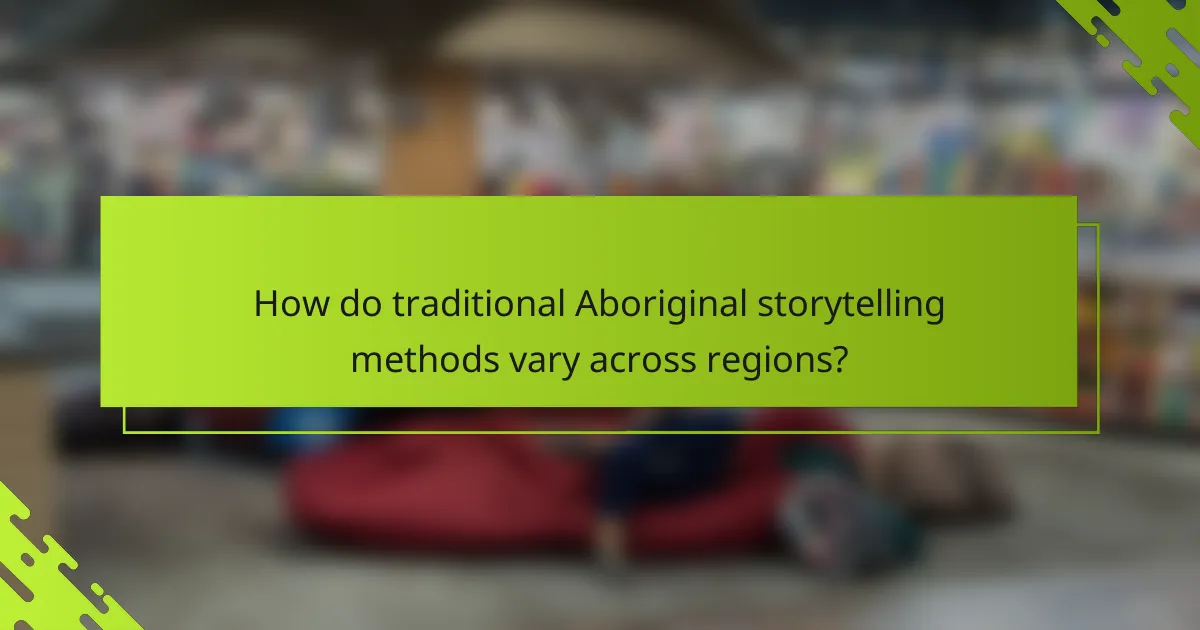
How do traditional Aboriginal storytelling methods vary across regions?
Traditional Aboriginal storytelling methods vary significantly across regions due to cultural diversity and local traditions. Different communities employ unique techniques, such as oral narratives, song, and dance, to convey their histories and teachings. For instance, the Yolŋu people in Arnhem Land utilize songlines, which are intricate pathways that connect locations to stories. In contrast, the Noongar people of Western Australia often incorporate visual art and performance in their storytelling, emphasizing community participation. Additionally, some regions emphasize the use of traditional languages, while others may adapt stories into contemporary formats, showcasing their relevance today.
What are the key components of oral storytelling in Aboriginal cultures?
Aboriginal storytelling relies on key components such as oral tradition, cultural symbolism, and community engagement. These elements ensure stories are passed down, preserving cultural identity and knowledge. Oral tradition emphasizes spoken narratives, while cultural symbolism conveys deeper meanings. Community engagement fosters collective participation in storytelling, reinforcing social bonds and shared values.
Which instruments and visual aids enhance storytelling experiences?
Visual aids such as traditional art, music, and dance enhance Aboriginal storytelling experiences. These instruments create immersive environments that engage the audience emotionally and culturally. For example, visual storytelling through paintings often illustrates significant narratives, while music adds rhythm and depth. Dance also plays a crucial role, embodying stories and connecting the community. Together, these elements preserve cultural heritage and ensure contemporary relevance, making storytelling a vibrant practice.
How do storytelling techniques differ between urban and rural Aboriginal communities?
Storytelling techniques differ between urban and rural Aboriginal communities primarily due to cultural context and accessibility. Urban communities often blend traditional narratives with contemporary influences, while rural storytelling tends to maintain stronger ties to ancestral practices and local landscapes.
Urban storytelling may utilize modern mediums like digital platforms to reach wider audiences, incorporating fast-paced narratives. In contrast, rural storytelling emphasizes oral traditions, focusing on slower, immersive experiences that foster community connections.
Additionally, the themes in urban stories may reflect issues like identity and adaptation, while rural narratives often celebrate nature and heritage. Both forms play crucial roles in preserving Aboriginal culture, adapting to contemporary relevance while honoring traditional roots.
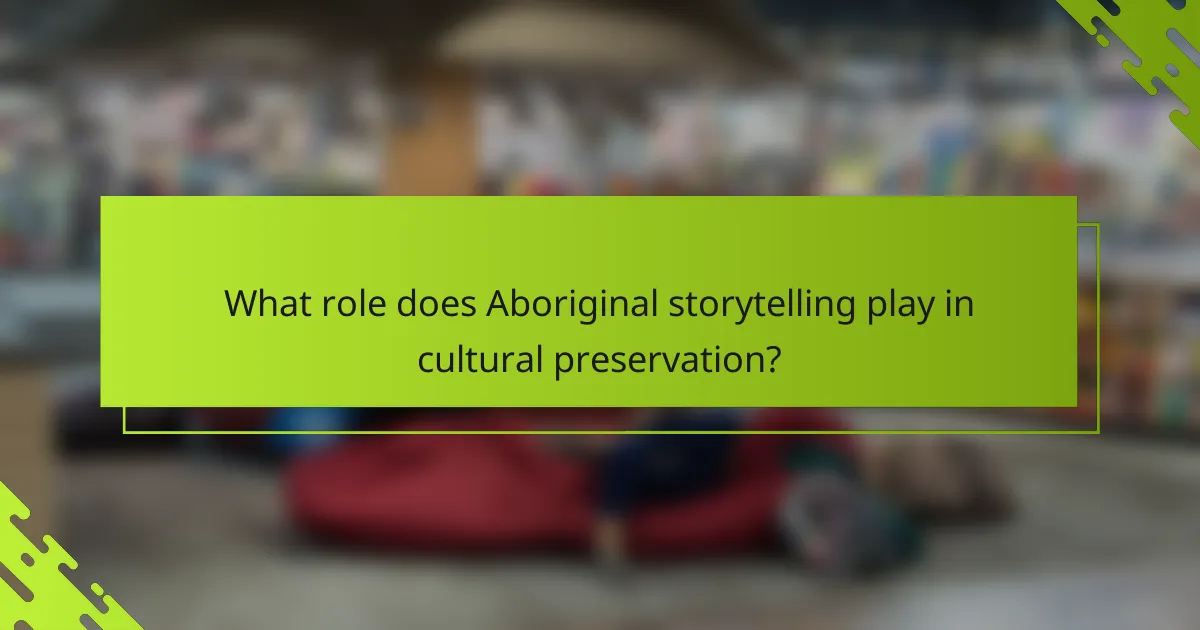
What role does Aboriginal storytelling play in cultural preservation?
Aboriginal storytelling plays a vital role in cultural preservation by transmitting knowledge, values, and traditions across generations. This method fosters community identity and continuity. Through oral narratives, Aboriginal cultures convey essential lessons about the environment, social structures, and spiritual beliefs. These stories serve as living archives, maintaining cultural integrity in a rapidly changing world. As contemporary relevance increases, storytelling adapts to modern contexts while preserving core values, ensuring that Aboriginal heritage remains vibrant and accessible.
How does storytelling transmit knowledge and values across generations?
Aboriginal storytelling transmits knowledge and values through oral traditions, engaging listeners and fostering cultural continuity. Storytellers use methods like song, dance, and visual art to convey lessons and morals. These narratives often reflect the unique relationship between Aboriginal peoples and their land, reinforcing identity and community values. Preservation efforts today include recording stories and integrating them into educational systems, ensuring their relevance for future generations.
What are the contemporary challenges to preserving traditional storytelling?
Contemporary challenges to preserving Aboriginal storytelling include cultural appropriation, loss of language, and digital distractions. These factors threaten the authenticity and transmission of traditional narratives. Cultural appropriation often leads to misrepresentation, while language decline reduces the ability to convey stories accurately. Digital distractions divert attention from oral traditions, making it harder for communities to engage with storytelling practices. As a result, the preservation of these narratives requires active efforts to promote cultural education and community engagement.
Which organizations support the preservation of Aboriginal storytelling practices?
Several organizations support the preservation of Aboriginal storytelling practices. Notable examples include the National Indigenous Television (NITV), which broadcasts Indigenous narratives, and the Australian Institute of Aboriginal and Torres Strait Islander Studies (AIATSIS), which archives cultural heritage. Additionally, local community groups and cultural centers often facilitate storytelling workshops to engage younger generations. These efforts enhance the contemporary relevance of Aboriginal storytelling by fostering intergenerational connections and cultural continuity.
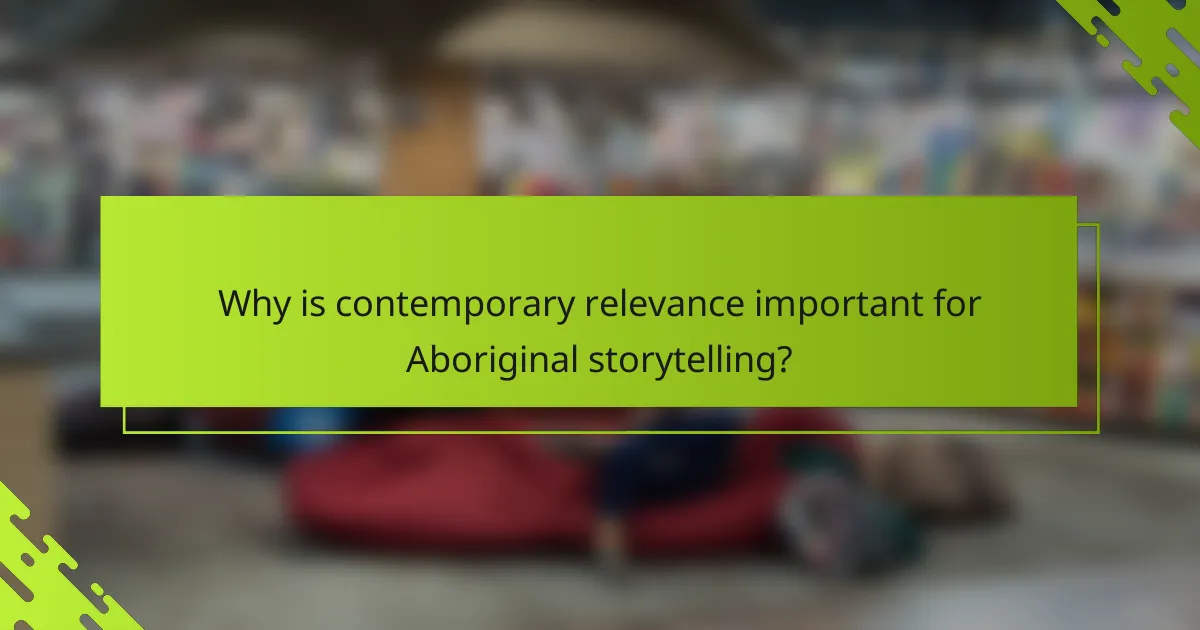
Why is contemporary relevance important for Aboriginal storytelling?
Contemporary relevance is crucial for Aboriginal storytelling as it ensures cultural preservation and adaptation. By integrating modern themes and mediums, these stories resonate with younger generations, fostering identity and connection. Engaging contemporary issues allows for broader understanding and appreciation of Aboriginal cultures, enhancing their visibility in society. This relevance helps maintain the vitality of traditions while promoting dialogue and reconciliation.
How do modern technologies impact the sharing of Aboriginal stories?
Modern technologies enhance the sharing of Aboriginal stories through digital platforms and social media. These tools enable wider reach, allowing Indigenous voices to share narratives globally. Technologies like podcasts, video storytelling, and interactive apps preserve cultural heritage while engaging younger audiences. The use of virtual reality provides immersive experiences, deepening connections to stories and traditions.
What are the benefits of incorporating Aboriginal storytelling in education?
Incorporating Aboriginal storytelling in education enhances cultural understanding and respect. It promotes critical thinking, creativity, and community connections. Storytelling preserves Indigenous knowledge and traditions, fostering a sense of identity among students. This method also encourages empathy and emotional intelligence, vital for holistic education.
How can Aboriginal storytelling foster reconciliation and understanding in diverse communities?
Aboriginal storytelling fosters reconciliation and understanding by sharing cultural narratives that promote empathy and respect. These stories often reflect the values, history, and perspectives of Aboriginal communities, creating a bridge to diverse audiences. Through oral traditions, storytelling preserves knowledge and fosters dialogue, encouraging mutual understanding. Engaging with these narratives can challenge stereotypes and deepen connections among different cultural groups. As a result, communities can work towards healing and collaboration, recognizing the shared humanity in each story.
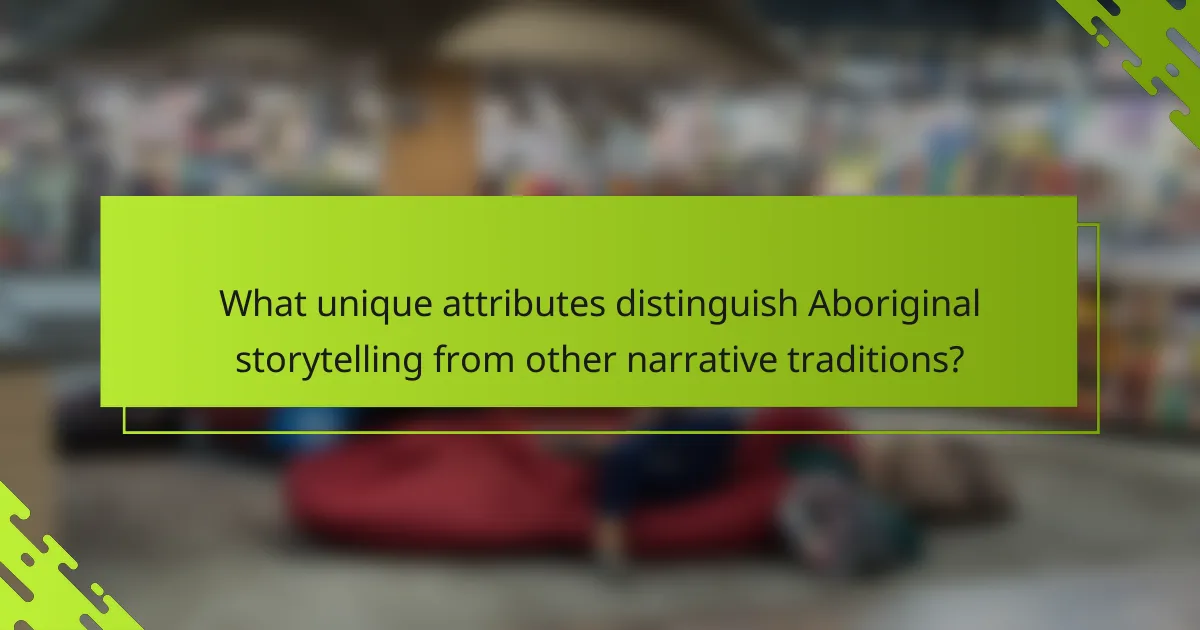
What unique attributes distinguish Aboriginal storytelling from other narrative traditions?
Aboriginal storytelling is distinguished by its deep connection to culture, spirituality, and land. Unique attributes include oral tradition, communal participation, and a focus on moral lessons. These narratives often incorporate Dreamtime stories, which explain the origins of the world and its inhabitants. Additionally, storytelling serves as a means of preserving history and knowledge across generations.
How do personal experiences shape individual storytelling styles?
Personal experiences significantly influence individual storytelling styles by shaping perspectives and emotional connections. Aboriginal storytelling reflects this through oral traditions, where personal narratives intertwine with cultural heritage. The unique attributes of these stories, such as their focus on community values and environmental connections, enhance their relevance today. As a result, personal experiences not only enrich the storytelling process but also preserve vital cultural knowledge across generations.
What rare themes and motifs are found in specific Aboriginal stories?
Aboriginal stories often feature rare themes and motifs that reflect deep cultural connections. Unique elements include the concept of “Dreamtime,” which represents the creation period and spiritual beliefs. Another rare motif is the use of animal totems, symbolizing kinship and identity. Additionally, stories may explore themes of land stewardship, emphasizing the relationship between people and nature. These motifs are vital for understanding the cultural significance and contemporary relevance of Aboriginal storytelling.
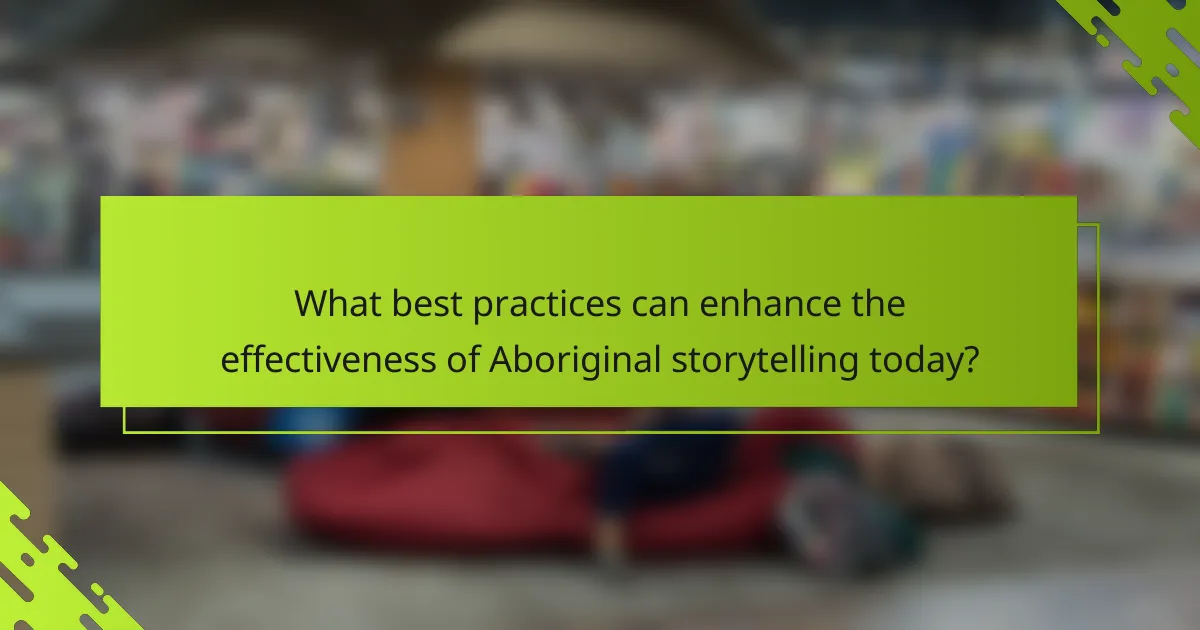
What best practices can enhance the effectiveness of Aboriginal storytelling today?
Aboriginal storytelling can be enhanced today through community engagement, digital preservation, and intergenerational knowledge transfer. These practices ensure cultural authenticity and relevance in modern contexts.
Community engagement fosters participation and collaboration, allowing stories to reflect contemporary issues while honoring traditional narratives. Digital preservation utilizes technology to archive stories, making them accessible to wider audiences. Intergenerational knowledge transfer promotes the sharing of stories between elders and youth, ensuring continuity of cultural practices and values.
By integrating these best practices, Aboriginal storytelling can thrive and adapt while maintaining its rich heritage.
How can storytellers engage audiences in both live and digital formats?
Storytellers can engage audiences in live and digital formats by utilizing immersive techniques and interactive elements. Aboriginal storytelling emphasizes oral traditions, often incorporating visual arts and music to enhance connection. In live settings, physical presence and community involvement create a shared experience. Digital formats allow for broader reach, using multimedia tools to present narratives. Unique attributes like cultural authenticity and the integration of traditional knowledge foster relevance. Engaging storytelling maintains audience interest through relatability and emotional resonance, crucial for both formats.
What common mistakes should be avoided when sharing Aboriginal stories?
Avoiding common mistakes in sharing Aboriginal stories is essential for respectful and accurate representation. Key mistakes include misrepresenting cultural significance, neglecting proper context, and failing to obtain consent from storytellers.
Additionally, oversimplifying narratives can strip them of their depth and meaning. It’s crucial to approach these stories with sensitivity and an understanding of their unique attributes, such as oral traditions and community ties. Recognizing the contemporary relevance of these stories enhances their preservation and appreciation.
Which strategies can storytellers use to ensure cultural sensitivity and respect?
Storytellers can ensure cultural sensitivity and respect by actively engaging with Aboriginal communities and incorporating their perspectives. This involves acknowledging traditional knowledge and practices, using appropriate language, and avoiding stereotypes. Collaborating with Indigenous storytellers can enhance authenticity and foster mutual respect. Additionally, educating audiences about cultural contexts enriches the storytelling experience.
